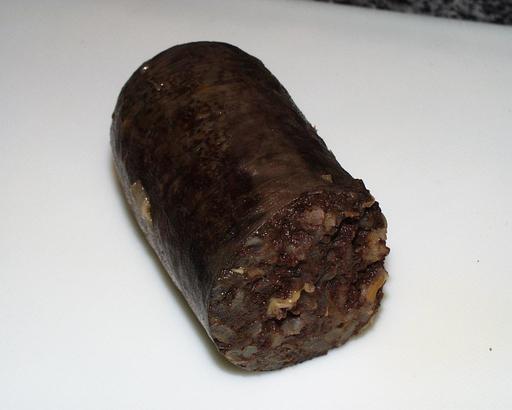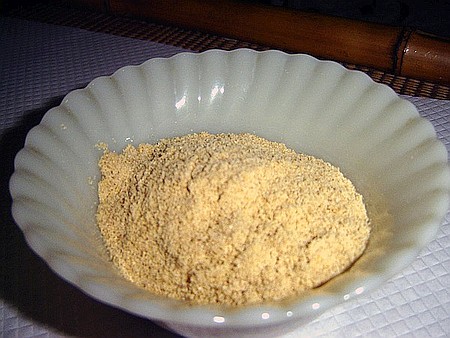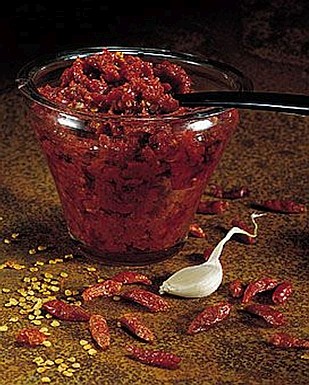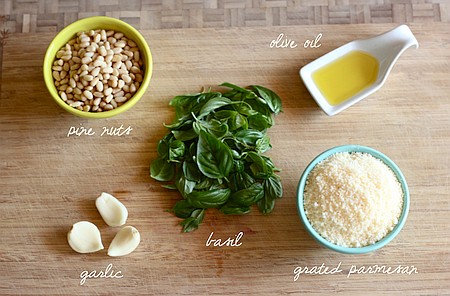Miscellaneous Condiments
Black Pudding
Ray Martin
Kevin Wilson
Farofa - Roberta Lovatelli
Harissa (Hot Chili Paste)
Paula Wolfert in Mediterranean Cooking
Cooking Live - Show #CL8870
Nutbutters - Alice Gomez
Italian Bread: Taking a Dip - Marian Van Til
The Pesto Controversy
Doug Essinger-Hileman Sparks the Controversy
Jessie Strader Rebuts
Anna Ravano Defends Pesto with Basil
John Marmet Defends Basil, Too
Jessie Strader's Basil-less Sun-dried Tomato Pesto
Savory Nuts - Alice Gomez
Soured Cream, Naturally - Astrid Bear
Tzidziki - Theo Gazulis
Black Pudding

Black Pudding image from Wikimedia Commons: Morcilla Cocida
Ray Martin
Black pudding was regarded as a northern, working-class dish in Britain until the southern middle classes started buying properties in France and discovered that the French adore le Boudin noir.
Suddenly it became a fashionable starter in all sorts of trendy establishments. Served with Bramley apple sauce or Dijon mustard.
Still a staple part of the "Full English" breakfast in Northern England, Ireland and Scotland.
We shall not, even touch upon the subject of Mar**e. Which none of The Surprise's crew would have known at all.
Kevin Wilson
...adding his name to the list of them that has tried it and liked it, Sam I am.
Which my Scottish grandmother served black pudding as a holiday treat, mostly at breakfast, but on those American holidays like Christmas when she'd been to the bakery that made up the steak and kidney for the dinner table, and the first time I made it to the U.K. on my own travels, I had to have it with breakfast. Even better, though perhaps only because it had been a decade or more since my grandparents died and no one else wants it around the house.
An acquired taste, probably, but one I acquired in youth. You just don't think on the "blood" bit too much (I'm quite sure the Jewish side of my family is less tolerant of such than the Presbyterian one) and it's splendid stuff. Besides which, if your next meal is likely to be steak and kidney, what's to cringe about?
Farofa - Roberta Lovatelli

Image from Wikimedia Commons: Farofa
You buy a bag of manioc flour. In the largest skilled you posses cook some bacon very smally chopped until crunchy. You get some bananas, cut them small and fry them on the same oil as the bacon. Dry and put aside. One the same skilled where the bacon was add some butter and oil (if needed) and throw in the manioc flour. It'll look very powdery for you but just keep on frying until it acquires a beige/light brown colour and dryer look. Add salt and pepper to taste and throw in the bacon and banana until all mixed together at the same time. Serve as accompany to the Feijoada.
Harissa (Hot Chili Paste)

Harissa image from the defunct site yumsugar
Paula Wolfert in Mediterranean Cooking
3 ounces mild and hot chilies -- dried mixture of anchos, New Mexican and guajillos
1 clove garlic -- crushed with salt
1/4 teaspoon salt -- for above
1 teaspoon coriander -- ground
1 teaspoon caraway seed -- ground
1 red bell pepper -- roasted
1 teaspoon fine sea salt
Olive oil
Stem, seed and break up chilies. Place in a bowl and pour over boiling water. Cover and let stand 30 minutes. Drain; wrap in cheesecloth and press out excess moisture. Do the same for the red Bell Pepper. Grind chilies in food processor with garlic spices, red bell pepper, and salt. Add enough oil to make a thick paste. Pack the mixture in a small dry jar; cover the harissa with a thin layer of oil, close th with a lid and keep refrigerated. Will keep 2 to 3 weeks in the refrigerator with a thin layer of oil.
Table harissa sauce.
Serve at the table as an accompaniment to meat or fish, the heighten the flavor of salads, or as an accompaniment to Tunisian couscous: Combine 4 teaspoons harissa paste, 4 teaspoons water, 2 teaspoon olive oil, and 1 or 2 teaspoons fresh lemon juice in a small bowl and blend well. Makes 1/4 cup.
Cooking Live - Show #CL8870
1 cup red pepper flakes
3 tablespoons paprika
3 garlic clove -- minced
1 teaspoon ground coriander
3 teaspoons ground caraway
2 tablespoons water -- (up to 3)
Olive oil
In a food processor or blender combine the pepper flakes, paprika, garlic, coriander, caraway, 2 teaspoons water and 3 to 6 tablespoons olive oil. Puree until mixture forms a paste, adding additional water and/or oil if necessary. Transfer to a jar and cover with olive oil.
Harissa will keep in the refrigerator for up to 6 months. Yield: about 1 cup.
Nutbutters - Alice Gomez
Why not make your own nutbutters? It's incredibly easy, not to mention much less expensive.
Some fresh (not dry roasted) peanuts in a food processor, a little peanut (or other) oil to keep the processing going, and Bob will kiss your hand. A little salt, if you wish. Want chunky? Save some peanuts to add towards the end of the processing. Et voilá! Instant peanut butter. This works for other nutbutters too - I've long wanted to make cashew butter but haven't yet. Pecan butter is good, and can be spread with other spices on a pork tenderloin, or mixed with honey or cream cheese for a topping on say, a cranberry-nut bread or scone.
I store nutbutters in the fridge - no preservatives, you see.
Italian Bread: Taking a Dip - Marian Van Til
Have you tried, in place of garlic bread (soaked with butter and garlic salt, or even fresh garlic) the traditional olive oil, herbs and balsamic vinegar on a plate into which you dip your Italian bread? This is so good I get cravings for it now and then and eat it as a snack, never mind the pasta, salad, wine, et al, that usually goes with it at a meal.
The Pesto Controversy

Image from Wikimedia Commons: Pesto Ingredients
Doug Essinger-Hileman Sparks the Controversy
It grates on my nerves every time I hear them refer to the topping as basil pesto. For God's sake, pesto by nature is made with basil, eh?
Jessie Strader Rebuts
Nay! Basil pesto is not a redundant redundancy. "Pesto" refers to the process of production: to the grinding and pounding and crushing of the ingredients with a pestle, not to the ingredients themselves, which may or may not include basil.
The pesto with basil to which you refer is simply the most common of many variants: the "alla Genovese" variant, containing basil, salt, garlic, olive oil and a good hard cheese such as Parmesan or Romano. It may or may not contain pine nuts or walnuts. But! Pesto can also be made with almost any green herb -- cilantro, parsley, arugula, oregano, chives, spinach, for example -- or even forego greenness altogether and use sun dried tomatoes (my fave!) or mushrooms as a base.
So have a kindness on the folks who say "basil pesto": they are nae more than deep-seated foodies striving for precision.
Anna Ravano Defends Basil
As half Genoese I must step in to defend the fully Genovese identity of pesto. The word itself is Italian, and in Italy it only refers to the basil-based sauce typical of Genoese cuisine, exclusively made the small-leaved variety of basil grown around Genoa.
It was only when this sauce started to be commercialized and proved successful (it was made with any variety of basil) that other producers got on to the bandwagon and put other sauces on the market that had only a few or none of the real pesto ingredients, calling them "pesto alla...whatever". Unfortunately no one at the time thought of getting the name "pesto genovese" officially protected, like "Champagne" or "Stilton cheese". However a "Consorzio del pesto genovese" was created in 2000 to get that recognition, and it scored its first success in 2005, when the European Commission granted "basilico genovese" the PDO (Protected Designation of Origin, DOP in Italian) label: Basilico_Genovese.pdf.
As a consequence now "pesto genovese" can only be used for pesto made with Genoese basil. And although EC directives are only valid within the EU, all the other sauces that have "pesto" in their names are just imitations, and if basil is not an ingredient, gastronomically and morally if not legally speaking, they shouldn't use the name of "pesto" at all.
John Marmet Defends Basil, Too
I believe even red pesto (the sun dried tomato kind) has basil in it.
Jessie Strader's Basil-less Sun-dried Tomato Pesto
1/2 cup sun-dried tomatoes (packed in oil)
2 Tb extra virgin olive oil
1/4 cup Parmesan cheese, grated
1 clove garlic (plus another if you really, really like garlic)
Salt and pepper to taste
1/4 cup pine nuts, toasted
Drain oil from tomatoes. Combine all in food processor and process until smooth (I add the oil gradually).
There are a lot of sites on the web with non-basil pesto recipes. Look especially at the cilantro pestos which are great bases for both Hispanic and Asian dishes. I'm intrigued by their beet pesto and the gingered mint pesto, neither of which I've ever encountered before. I'll letcha know!
Then of course, there's chimichurri sauce, of Argentinian origin, which is a pesto made of parsley, garlic, oregano, lemon, red onion, oil and red wine vinegar: to die for on a rare steak.
Branch out! Explore the pestos of this world. Some are thick, some are thin, and not all have basil in them.
Savory Nuts - Alice Gomez
One of the Christmas token gifts I'm giving to co-workers this is year is Savory Nuts, which are pretty tasty. This was in the November, 2002, Better Homes and Gardens, IIRC.
1 egg white
1/2 teaspoon salt
1/2 teaspoon ground black pepper
2 teaspoons herbs (I used 1/2 teaspoon each minced fresh rosemary and sage, and 1/2 teaspoon each dried basil and Italian Herbs)
3 cups walnuts pieces, whole hazelnuts, or almonds or a combo
Beat the egg white till bubbly with a fork (doesn't have to be stiff peaks), fold in the spices till blended, then fold in the nuts. (I know, one egg white doesn't sound like it would be enough, but it is.)
Spread onto a greased or sprayed cookie sheet and bake at 350 for 15 to 20 minutes until browned. Stir half way through. (I forgot to do that, and they came out OK.) Break into small pieces. Can be frozen.
Soured Cream, Naturally - Astrid Bear
The invaluable Diana Kennedy has this to say: "In large urban areas it is difficult, if not impossible, to find pure, naturally soured cream, just like the creme fraiche of France. The commercial brands certainly have filler and preservatives, and much that is sold in local marketplaces in central Mexico has been extended with some sort of vegetable fat. While these sour creams are adequate as toppings for antojitos and the like, the are not suitable to be cooked into a sauce. You can buy some delicious sour cream in markets like Juchitan in southern Oaxaca, for instance, and some that has been churned for mantequilla de rancho, a soft, slightly cheesy "ranch butter" that is delicious spread on tortillas.
Some very good brands of creme fraiche are now available in the United States, and they are worth the extra cost. I could never recommend the product sold under the name Mexican Crema in a glass jar; it is certainly not worth the price.
Of course, you can always make your own, as Julia Child taught us many years ago.
Thick Sour Cream
1 cup heavy (not ultrapasteurized) cream
Appox. 3 T. buttermilk or yoghurt (not low-fat)
Mix cream and buttermilk in a glass container and set in a warm place (oven with a pilot light, in a yoghurt maker, etc.) overnight. It should have soured slightly and thickened in about 8 hours if you have natural products, but it may take longer. To have it really thick, make this homemade version several days ahead.
Prepared Sour Cream
A thinner, slightly soured, cream, is used lavishly over many antojitos. For this I suggest a short cut -- which is also cheaper -- by diluting sour cream with milk to the desired consistency."
---from "The Essential Cuisines of Mexico"
By antojitos, she means things we'd think of appetizers, tapas-like things. The word means literally, "little whim". A trifle, a kickshaw? Which puts us back to POB territory!
Tzidziki - Theo Gazulis
The cucumber sauce is tzid-ZI-ki. Shred 1 cucumber in a bowl; drain any liquid. Add 3 (or more) cloves crushed garlic. Blend very well. Add 2 cups plain yogurt, 3 tablespoons olive oil (Greek, of course - I have to support my cousin's business), 1 teaspoon (more or less) lemon juice, some chopped red or green onion, maybe some mint. Blend all together, chill well and serve.
Note the lack of precision in measurements. That's how I learned it from my grandmother.
Also, if you want it to be more "sauce-like", use more yogurt. If you want more of a salad, coarsely chop or slice the cucumber.
